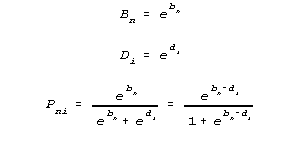
In statistical terminology, "sufficient" means "all the information that this dataset has about ...". So, from a Rasch perspective, the "raw score" has all the information there is in the dataset about the "ability" of the respondent. This is also the Classical Test Theory perspective. But this is not the 2-PL or 3-PL perspective. They say that the "pattern of responses" has all the information there is in the dataset about the "ability" of the respondent.
1. Person n of ability Bn responds to test items (i) with difficulties (Di) with scored (0,1) responses (Xni). For the raw score Rn = ΣXni to be sufficient for estimating ability, indeed, for counting right answers to be useful at all, Rn must extract ability Bn out of (Xni).
2. Bayes says that the probability of person n's response vector, given person ability Bn and items of difficulty (Di), is the probability of the response vector given the raw score Rn multiplied by the probability of the raw score given the ability:
P{(Xni)|Bn,(Di)} = P{(Xni)|Rn,(Di)} * P{Rn|Bn,(Di)}
3. If Pni = f(n,i) is the probability that n succeeds on i, then we can obtain the probability of person n's method of obtaining a score of Rn, and also all other methods of obtaining the same score.

|
4. Rn points unequivocally to ability Bn only if P{(Xni)|Rn, (Di)}, the probability of the particular responses given the raw score, is entirely free from variation due to Bn. Thus the remainder must be locally independent of Bn so that it does not matter which particular (Xni) are 1's and which are 0's provided that ΣXni = Rn. Thus the effect of Bn on the (Xni) can be factored out of (3) and cancelled.
[This is saying that the set of response vectors are locally independent given the person abilities and the item difficulties. Georg Rasch called this property "specific objectivity".]
5. A sufficient factoring is obtained by asserting that
Cni = Bn + Di,
Pni = Bn / Cni, and 1- Pni = Di / Cni, then
  |
so that

|
is seen to be free of Bn.
6. Thus a sufficient parameterization is
|
|
Reparameterizing,

|
produces the Rasch model, showing that this form of f(n,i) supports the use of Rn for estimating the ability of person n.
7. The necessity of this formulation can be demonstrated by dividing the numerator into the denominator in (3) to produce the following term in the denominator, which must not vary with Bn:

|
8. In T there are the same number of Pni and Pnj terms in each product, because the raw score is invariant across the summation. The general condition for T not to vary with Bn, (apart from irrelevant specifics, such as when Pni and Pnj are constants), is that
|
|
which takes us to step (2) of Model Necessary for a Thurstone Scale, RMT 2:1 p. 9-10, and thence to the Rasch model as the necessary f(n,i).
Benjamin D. Wright
Note: Since most of Classical Test Theory (CTT) regards the raw scores as sufficient for decision-making, CTT implicitly assumes that the Rasch model holds for their data.
Dichotomous Rasch Model derived from Counting Right Answers: Raw Scores as Sufficient Statistics. Wright BD. … Rasch Measurement Transactions, 1989, 3:2 p.62
| Forum | Rasch Measurement Forum to discuss any Rasch-related topic |
Go to Top of Page
Go to index of all Rasch Measurement Transactions
AERA members: Join the Rasch Measurement SIG and receive the printed version of RMT
Some back issues of RMT are available as bound volumes
Subscribe to Journal of Applied Measurement
Go to Institute for Objective Measurement Home Page. The Rasch Measurement SIG (AERA) thanks the Institute for Objective Measurement for inviting the publication of Rasch Measurement Transactions on the Institute's website, www.rasch.org.
| Coming Rasch-related Events | |
|---|---|
| Jan. 16 - Feb. 13, 2025, Fri.-Fri. | On-line workshop: Rasch Measurement - Core Topics (E. Smith, Winsteps), www.statistics.com |
| Apr. 8 - Apr. 11, 2026, Wed.-Sat. | National Council for Measurement in Education - Los Angeles, CA, ncme.org/events/2026-annual-meeting |
| Apr. 8 - Apr. 12, 2026, Wed.-Sun. | American Educational Research Association - Los Angeles, CA, www.aera.net/AERA2026 |
| May. 15 - June 12, 2026, Fri.-Fri. | On-line workshop: Rasch Measurement - Core Topics (E. Smith, Winsteps), www.statistics.com |
| June 19 - July 25, 2026, Fri.-Sat. | On-line workshop: Rasch Measurement - Further Topics (E. Smith, Winsteps), www.statistics.com |
The URL of this page is www.rasch.org/rmt/rmt32e.htm
Website: www.rasch.org/rmt/contents.htm